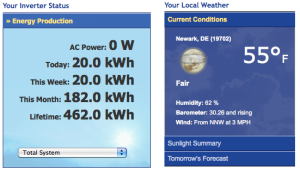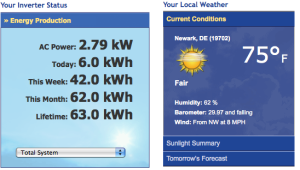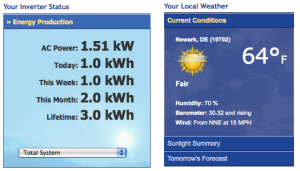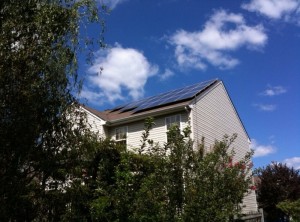Want 2GB of free space that you can access from any computer (Mac/PC), iPhone or web browser? Get Dropbox! Free 2GB accounts synchronize across all of your computers and to your iPhone. Easily share files/folders with any other Dropbox user. The files are stored locally on all machines so you can work “offline” and sync back up when you get a network connection again.
PV: Day 30
 So after 30 days, I am happy to report that the solar PV system has been working flawlessly. We’ve generated about 450 kWh (the web version shows a little more than the electro-mechanical version that’s metering the actual power).
So after 30 days, I am happy to report that the solar PV system has been working flawlessly. We’ve generated about 450 kWh (the web version shows a little more than the electro-mechanical version that’s metering the actual power).
Antioxidant Foolishness
 Really? Just because it has “antioxidants” it suddenly has a “healthy” glow? I’ll pass. Eat some real cherries instead and have a glass of water.
Really? Just because it has “antioxidants” it suddenly has a “healthy” glow? I’ll pass. Eat some real cherries instead and have a glass of water.
Drying for Freedom
 I’m an advocate for drying clothes outdoors. There are many reasons why I choose to do this but the biggest is the reduction in the utility bill (we have an electric clothes dryer). Even before we installed solar panels on the roof, I would hang laundry outside to reduce our carbon footprint.
I’m an advocate for drying clothes outdoors. There are many reasons why I choose to do this but the biggest is the reduction in the utility bill (we have an electric clothes dryer). Even before we installed solar panels on the roof, I would hang laundry outside to reduce our carbon footprint.
Jeff just tipped me off to a new movie coming out in 2010 called Drying For Freedom that explores the growing and reversing trend of drying clothes outside. The trailer mentions that $5 billion (yes BILLION) is spent on just drying clothes in America. What a waste! The movie also exposes the growing trend of communities passing laws that prohibit clothes lines. What this causes, according to the trailer, is to equate power consumption with status. (This sounds awfully familiar!)
UStream.tv Broadcaster on an iPhone (Jailbroken)
A while back I had jailbroken my original iPhone and installed the UStream.tv Broadcaster application. It was great and worked really well. If you have an iPhone 3G it will work over 3G as well as WiFi (sorry, no Edge).
No matter, since I got the 3G S, my 2G hasn’t had much love. So I picked it back up again and jailbroke it (OS 3.1) and went to look for the UStream Broadcaster app. I couldn’t find it, it was removed from Cydia. After some searching, I found the fix.
Found the Ustream streaming app.
Cydia/Manage/Sources/Edit/Add
Type
1999.ustream.tv
click Add SourceDownloaded it and it does not work on 3GS with OS 3.0
PV: Day 6
 Doing well!
Doing well!
PV: Day 1
 So far, so good.
So far, so good.
Talking to an old PTZ camera
 I recently obtained an old Polycom PTZ-1 camera. This camera went to an old video conferencing system, long past it’s usefulness in today’s era of instant desktop video conferencing ala Skype. The camera was inside a large plastic housing to keep it secure– I removed it from the housing to get a closer look.
I recently obtained an old Polycom PTZ-1 camera. This camera went to an old video conferencing system, long past it’s usefulness in today’s era of instant desktop video conferencing ala Skype. The camera was inside a large plastic housing to keep it secure– I removed it from the housing to get a closer look.
I know most cameras are controlled via RS-232 so I searched around and found a site that listed the control codes necessary to talk with this camera. I also found how to build the cable to go from a serial DB-9 to a mini-din 8 here. That’s where the Arduino comes in.
Previously, I figured out how to interface an NES joy-pad to the Arduino (even purchasing the proper female jacks so I wouldn’t need to cut the original cables). So I thought about marrying the camera with the controller. Behold, the the Picture PTZ-1 being controlled by the Arduino via an NES joypad.
The first problem I encountered was that the PTel PTZ-1 liked to talk serial using ODD parity. Yikes, I didn’t think the Arduino could do that. Well, it can actually. I found a forum posting that listed an extension to the serial protocol of the Arduino.
Although the Arduino has on board serial, it needs help to speak RS-232 serial (because of voltage differences). That’s where the MAX232 chip comes in and it’s cast of supporting capacitors.
Below is the Arduino sketch that I’m using. The code will pan and tilt the camera using the plus-pad. The A and B buttons control zoom in and out. Select and Start are for presets. The camera has 8 hardware presets. Press select the number of times equal to the preset you want and press start. To set a preset, press select the number of times equal to the preset, holding on the last preset and press start.
#include <SerialExtension.h>
# NES Controller Pin Setup
int latch = 8; // set the latch pin
int clock = 9; // set the clock pin
int datin = 10; // set the data in pin
# A Status LED To Light When Receiving input from NES
int ledpin = 13; // set the led status pin
# Zero Counters
int selects = 0;
int starts = 0;
unsigned char report[6];
unsigned char prev_report[6];
void setup() {
// Setup NES controller
pinMode(latch, OUTPUT);
pinMode(clock, OUTPUT);
pinMode(datin, INPUT);
pinMode(ledpin, OUTPUT);
digitalWrite(latch, HIGH);
digitalWrite(clock, HIGH);
Serial.begin(9600);
SetSerial(9600,’O’, 8, 1);
delay(500);
init_camera();
report[0]=0x80;
report[1]=0x80;
report[2] = report[3] = report[4] = report[5] = 0;
prev_report[0]=0x80;
prev_report[1]=0x80;
prev_report[2] = prev_report[3] = prev_report[4] = prev_report[5] = 0;
}
void loop () {
NEScontrollerRead();
// Tilt up begin
if ((report[1] == 0) && (prev_report[1] == 0x80)) { motion_begin(‘t’, ‘u’); }
// Tilt up stop
if ((report[1] == 0x80) && (prev_report[1] == 0)) { motion_stop(‘t’, ‘u’); }
// Tilt up cont
if ((report[1] == 0) && (prev_report[1] == 0)) { motion_cont(‘t’, ‘u’); }
// Tilt down begin
if ((report[1] == 0xFF) && (prev_report[1] == 0x80)) { motion_begin(‘t’, ‘d’); }
// Tilt down stop
if ((report[1] == 0x80) && (prev_report[1] == 0xFF)) { motion_stop(‘t’, ‘d’); }
// Titlt down cont
if ((report[1] == 0xFF) && (prev_report[1] == 0xFF)) { motion_cont(‘t’, ‘d’); }
// Pan left begin
if ((report[0] == 0) && (prev_report[0] == 0x80)) { motion_begin(‘p’, ‘l’); }
// Pan left stop
if ((report[0] == 0x80) && (prev_report[0] == 0)) { motion_stop(‘p’, ‘l’); }
// Pan left cont
if ((report[0] == 0) && (prev_report[0] == 0)) { motion_cont(‘p’, ‘l’); }
// Pan right begin
if ((report[0] == 0xFF) && (prev_report[0] == 0x80)) { motion_begin(‘p’, ‘r’); }
// Pan right stop
if ((report[0] == 0x80) && (prev_report[0] == 0xFF)) { motion_stop(‘p’, ‘r’); }
// Pan right cont
if ((report[0] == 0xFF) && (prev_report[0] == 0xFF)) { motion_cont(‘p’, ‘r’); }
// Zoom in begin
if ((report[2] == 1) && (prev_report[2] == 0)) { motion_begin(‘z’, ‘i’); }
// Zoom in stop
if ((report[2] == 0) && (prev_report[2] == 1)) { motion_stop(‘z’, ‘i’); }
// Zoom in cont
if ((report[2] == 1) && (prev_report[2] == 1)) { motion_cont(‘z’, ‘i’); }
// Zoom out begin
if ((report[3] == 1) && (prev_report[3] == 0)) { motion_begin(‘z’, ‘o’); }
// Zoom out stop
if ((report[3] == 0) && (prev_report[3] == 1)) { motion_stop(‘z’, ‘o’); }
// Zoom out cont
if ((report[3] == 1) && (prev_report[3] == 1)) { motion_cont(‘z’, ‘o’); }
// Select button function
if ((report[4] == 1) && (prev_report[4] == 0)) {
selects++;
if (selects > 8) { selects = 0; }
}
// Select and Start functions
// Goto preset
// Press “Select” times to equal the number of the preset
// then press “Start” to go to that preset.
if ((report[5] == 1) && (prev_report[5] == 0) && (report[4] == 0)) {
if (selects > 0) {
command_begin();
Serial.print(“g0”);
selects–;
Serial.print(selects);
Serial.print(“n”);
command_end();
selects = 0;
}
}
// Store preset
// Press “Select” times MINUS 1 equal to the numer of the preset to SET
// Press and HOLD “Select” on the last number and press “Start” to set the preset
if ((report[4] == 1) && (report[5] == 1) && (prev_report[5] == 0)) {
if (selects > 0) {
command_begin();
Serial.print(“s00”);
selects–;
Serial.print(selects);
command_end();
selects = 0;
}
}
prev_report[0] = report[0];
prev_report[1] = report[1];
prev_report[2] = report[2];
prev_report[3] = report[3];
prev_report[4] = report[4];
prev_report[5] = report[5];
delay(100);
}
void NEScontrollerRead() {
int x = 0x80, y = 0x80; // 0x80 = 128 = axis centered (nothing pressed)
int a, b, select, start, led = 0;
report[0] = report[1] = report[2] = report[3] = report[4] = report[5] = 0;
unsigned char tmp = 0;
digitalWrite(latch, LOW);
digitalWrite(clock, LOW);
digitalWrite(latch, HIGH);
delayMicroseconds(2);
digitalWrite(latch, LOW);
// button A
a = !digitalRead(datin);
NESCycleClock();
// button B
b = !digitalRead(datin);
NESCycleClock();
// button Select
select = !digitalRead(datin);
NESCycleClock();
// button Start
start = !digitalRead(datin);
NESCycleClock();
// button Up
if (!digitalRead(datin)) { y = 0; led = 1;}
NESCycleClock();
// button Down
if (!digitalRead(datin)) { y = 0xff; led = 1; }
NESCycleClock();
// button Left
if (!digitalRead(datin)) { x = 0; led = 1; }
NESCycleClock();
// button Right
if (!digitalRead(datin)) { x = 0xff; led = 1; }
NESCycleClock();
report[0] = x;
report[1] = y;
report[2] = a;
report[3] = b;
report[4] = select;
report[5] = start;
//report[2] = (a << 0) + (b << 1) + (select << 2) + (start << 3);
if (a || b || select || start || led) { digitalWrite(ledpin, 1); }
else { digitalWrite(ledpin, 0); }
}
void NESCycleClock() {
delayMicroseconds(4);
digitalWrite(clock, LOW);
digitalWrite(clock, HIGH);
delayMicroseconds(2);
}
void command_begin() {
Serial.print(0x02, BYTE);
Serial.print(“ck”);
}
void command_end() {
Serial.print(0x04, BYTE);
}
void init_camera() {
command_begin();
Serial.print(“k”);
command_end();
command_begin();
Serial.print(“i0n”);
command_end();
// Wait for an ACK from camera
while(Serial.read() != 0x04) {}
command_begin();
Serial.print(“d0”);
Serial.print(0xF2, BYTE);
command_end();
delay(100);
// Wait for an ACK from camera
while(Serial.read() != 0x04) {}
command_begin();
Serial.print(“z0m”);
command_end();
// Wait for an ACK from camera
while(Serial.read() != 0x04) {}
}
void motion_begin(char axis, char dir) {
command_begin();
Serial.print(“r0k”);
Serial.print(axis, BYTE);
Serial.print(dir, BYTE);
if (dir == ‘u’) { Serial.print(“099”); }
if (dir == ‘d’) { Serial.print(“097”); }
if (dir == ‘l’) { Serial.print(“100”); }
if (dir == ‘r’) { Serial.print(“101”); }
command_end();
}
void motion_cont(char axis, char dir) {
command_begin();
Serial.print(“c0k”);
Serial.print(axis, BYTE);
Serial.print(dir, BYTE);
command_end();
}
void motion_stop(char axis, char dir) {
command_begin();
Serial.print(“p0k”);
Serial.print(axis, BYTE);
Serial.print(dir, BYTE);
command_end();
}
Solar Success
 Today was the first day we had the solar panels turned on since they were installed last week. (We were waiting for the final inspection and the orientation session on how not to get ourselves electrocuted.) Unfortunately, today was a very cloudy day with some rain (unlike the picture here) there was no sun to be had. But I have high hopes for the remainder of the summer season, especially with the cool weather we’re having now.
Today was the first day we had the solar panels turned on since they were installed last week. (We were waiting for the final inspection and the orientation session on how not to get ourselves electrocuted.) Unfortunately, today was a very cloudy day with some rain (unlike the picture here) there was no sun to be had. But I have high hopes for the remainder of the summer season, especially with the cool weather we’re having now.
The system is internet-enabled, sending statistics from the inverter to an online site that will create fancy graphs and such so we’ll be able to track our “investment.” At full capacity, it will generate 3.67 kilowatts of power (18 panels total).
DIY Retro Cellphone Handset
 My next project, a DIY handset to cell phone adapter. It’s simply exchanging one plug for another, pretty straight forward.
My next project, a DIY handset to cell phone adapter. It’s simply exchanging one plug for another, pretty straight forward.